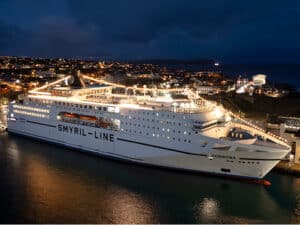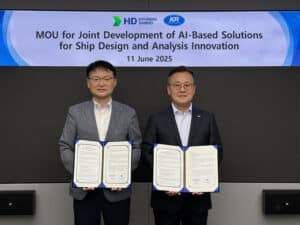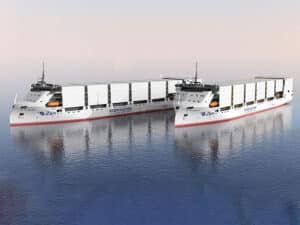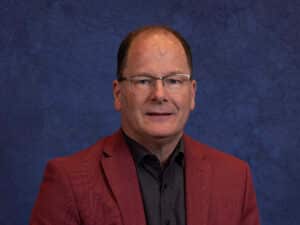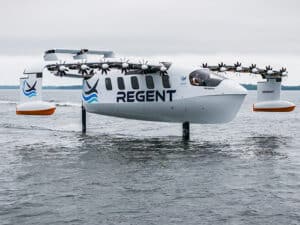
Future ferries: Some may fly, most won’t
Written by Nick Blenkey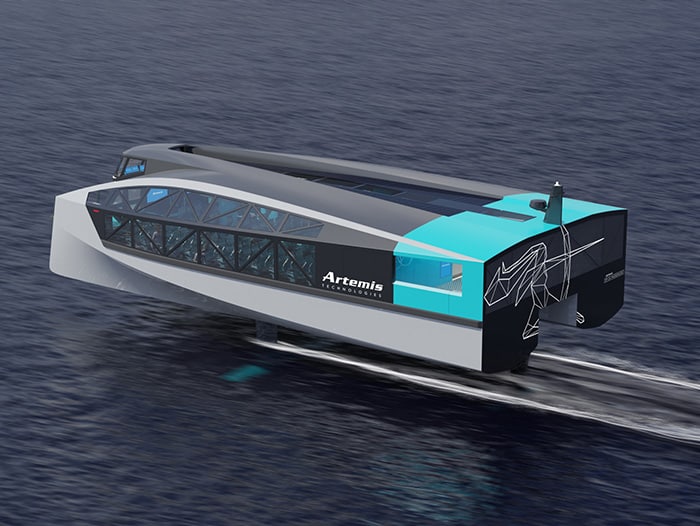
Artemis Technologies sees the future of ferries as foil-borne — and it already has a 12-meter prototype making demo runs. (Credit: Artemis Technologies)
Back in the 1960s, there was all sorts of buzz around hovercraft and hydrofoils. With some impressive deliveries—like the Boeing JetFoil—they were going to change the face of the ferry industry. Except they didn’t. Times change, however, and spectacular advances in technology and materials promise to make a new generation of flying ferries a far more practical proposition for real life use.
We’ll look at some of the competitors entering this race in more detail later. But for most ferries, on most routes, the odds are that future ferries won’t look a whole lot different than those currently in service. One reason for that is that many of those future vessels will be existing ones updated. Another is that, even for newbuilds, the external envelope of a ferry is dictated by factors that include its route, the terminals served and the number of passengers and or vehicles carried.
Internally, the story is going to be very different. For hybrid vessels, batteries and cabling and electric drives must become part of the picture. For pure electric vessels, batteries will become a very large part of the picture, as will systems for shoreside charging. If the choice it to go electric with fuel cells rather than batteries then a whole further range of challenge opens, not the least of them being regulatory.
The point about future ferries being today’s vessels re-imagined is well-illustrated by America’s largest ferry operator, Washington State Ferries (WSF). Moving ahead on its ambitious electrification program, it has awarded Vigor a shipyard contract for the conversion of up to three Jumbo Mark II-class ferries to hybrid-electric power. As well as converting WSF’s largest ferries to hybrid-electric, Vigor will also update the vessels’ aging propulsion system controls to extend the life expectancy of the ferries.
Following a competitive process among Washington State shipbuilders, Vigor’s winning bid was just over $150 million. The second bid came in at approximately $166 million. The state’s estimate was approximately $120 million.
“This contract is a big step toward providing our ferry-served communities with better air quality and more sustainable service,” said Matt von Ruden, system electrification program administrator at WSF. “We’re tackling the biggest emitters in our fleet first, the Jumbo Mark IIs, which contribute 26% of our ferries’ greenhouse gas emissions. When our terminals are electrified in 2026, we expect emissions from these three vessels to drop by roughly 95%.”
In addition to the hybrid-electric conversion, the contract includes planned replacement of the propulsion control systems. The three vessels are experiencing equipment failures and replacement parts are often unavailable. This effort will increase reliability and ensure the Jumbo Mark IIs are available for decades to come, says WSF.
The Jumbo Mark II conversions will not reduce vehicle or passenger capacities (202 vehicles and 2,500 passengers) or vessel speeds, says WSF. The addition of the battery banks and other systems will increase the vessel weight by about 140 long tons (2,240 lbs. per long ton), which is about three percent. Once the terminals have charging capacity, the vessels will carry less fuel, compensating for the increased weight. Vessels will charge each time they dock at a charging terminal.
Why convert to hybrid-electric and not full electric? “Hybrid-electric power is our best option for system resiliency,” says WSF. “Keeping diesel as a backup power source ensures we can continue service while building terminal charging infrastructure and the case of any issues with the batteries or interruptions to our shore-based electric power.”
Conversion of the state’s largest ferries to hybrid-electric power marks WSF’s first step toward electrification of the ferry system. The program will:
- Retrofit six current diesel ferries to hybrid electric.
- Build 16 new hybrid vessels.
- Retire 13 diesel ferries.
- Add charging stations at 16 terminals.
The 16 new hybrid vessels will be lookalikes for WSF’s existing Olympic Class vessels, which have a capacity of 144 cars and 1,500 passengers.
Eventually, though, existing vessels do have to be replaced. Operators opting for the hybrid option for newbuilds include Casco Bay Lines of Portland, Me., which has a 164-foot hybrid-electric passenger /vehicle ferry on order at Senesco Marine shipyard in North Kingston, R.I. It has been designed by Elliott Bay Design Group (EBDG), which has supported Casco Bay Lines and its steering committee since 2018 as they prepared and planned for this replacement ferry, operating between Portland and Peaks Island, Maine. The contract design meets operational requirements, increased passenger demand and Casco Bay Lines’ goal of reducing their carbon footprint.
As part of the preliminary design efforts, EBDG prepared a propulsion selection study to compare various propulsion systems based on capital cost, operating cost, reliability, serviceability, CO2 emissions, and in port noise and exhaust generation.
The result is a ferry that features ABB Marine & Ports’ hybrid propulsion system supporting diesel-electric and zero-emissions battery-powered modes, as well as a combination of both. With the ferry operating in zero-emission mode, the passengers will benefit from a smoother, quieter, and cleaner ride. A Stemmann Technik FerryCHARGER shore charging system is also provided by ABB for rapid vessel charging in Portland.
The vessel will carry 15 vehicles and 599 passengers on three decks including a sun deck with unobstructed views. The double-ended configuration eliminates the need to turn the vessel around, reducing the required speed and energy consumption for the new vessel even though it is larger than the Machigonne II, which it replaces.
This is the second hybrid-electric ferry built by Senseco, which was selected to build a hybrid-electric passenger/vehicle ferry for the Maine State Ferry Service (MSFS). Designed by Gilbert Associates, the 154-foot vessel will feature a BAE Systems’ electric hybrid propulsion solution that will deliver reduced and zero-emission operations capability for the MSFS Rockland, Maine-based ferry service that serves nearly 500,000 riders and 190,000 vehicles each year.
Another hybrid ferry project with which EBDG is involved is the new 190-foot passenger/vehicle ferry that will operate between New York City’s Lower Manhattan and Governors Island. Under construction at Conrad Shipyard for the Trust for Governor’s Island, its hybrid system will allow it to toggle between zero-emission battery-only power and battery-assisted hybrid with diesel backup. The battery-assist mode will allow the new ferry to reduce carbon dioxide emissions by approximately 600 tons annually. Future plans for rapid vessel charging installation will enable the ferry to operate with zero-emission battery-only propulsion, at which point emissions will drop to nearly zero.
It will replace the diesel-powered Lt. Samuel S. Coursen, the Trust’s current vehicle and passenger ferry, which was commissioned by the U.S. Army in 1956 and has been in continuous use since 1956.
ALL-ELECTRIC: THE GREEN GOLD STANDARD
While the hybrid-electric option does give the comfort of a “suspenders and belt approach,” all-electric is the green gold standard. And America’s first all-electric ferry has been in operation since April 2019, when the historic Alabama Department of Transportation (ALDOT) Gee’s Bend ferry returned to service following conversion to all-electric operation electric-powered passenger/car ferry.
Operated by HMS Ferries on behalf of ALDOT, the 15-vehicle/132-passenger ferry, built in 2006, operates a 15-minute crossing of the Alabama River between Camden and Boykin, Ala.
Seattle, Wash., naval architecture and marine engineering firm Glosten, which provided concept through contract design and shipyard technical support for the electrification project, is now closely involved with an interesting all-electric ferry newbuild project. It is the designer of the all-electric ferry that Skagit County, Wash., is to build to replace the 40-year-old, diesel-powered M/V Guemes. The county has just requested shipyard bids to build the 28‐car Subchapter‐T replacement vessel, which has a steel hull and aluminum superstructure, with a propulsion plant consisting of two azimuthing thrusters, electrically driven by a battery‐electric system charged from shore.
FLYING FERRIES
Glosten is however also involved in a project to build a very different looking type of ferry — one that “flies” over the water on foils: The Glosten/Bieker Foil ferry. We have been following this project since it was first announced in 2020. Since then, there have been several parallel developments in Europe. Contenders to get the first all-electric foiling ferry into service include Belfast, Northern Ireland-based Artemis Technologies with its EF-24 Passenger, Condor Ferries, a long-established operator of ferries serving the mainland U.K., the Channel Islands and France, plans to operate in a pilot program, running between Belfast and Bangor, Northern Ireland, some time in 2024.
In Sweden, Candela Technology’s electric foiling vessels are already making inroads in the powerboat market where an expert jury named its Candela C-8 the European Powerboat of the Year 2023. The company also has big plans in the ferry market, it hopes to see its initial ferry model, the 12 passenger P-12 Shuttle, water-born at the end of 2023 and entering Stockholm city’s fleet of public transportation ferries in 2024 as a pilot on one of its main routes. What all these designs — and others — have in common is the use of electric drives, foiling technology, and lightweight composite construction to achieve an impressive combination of speed, range and low power consumption. Another Swedish design is Green City Ferries’ Beluga24. Built in light-weight carbon fiber and with a foil-assisted hull, it will carry147 passengers and 28 bicycles and offers two emission-free options – battery electric for short journeys and hydrogen fuel cell for long ones.
How is the Glosten/Bieker design progressing?
Preliminary design of the Glosten/Bieker Foil Ferry was funded by an FTA Accelerating Innovative Mobility grant. The report was delivered in April 2022 and has been under FTA review since then. Their review is about to conclude allowing it to finally be published.
Glosten and Bieker Boats were recently awarded a patent on the Foil Ferry collision absorption system. The patent, which underscores the team’s safety- and reliability-first design philosophy, setting it apart from international competition, was auspiciously awarded on July 4, 2023. The Foil Ferry collision absorption system is part of a multi-layered approach to safety; the vessel is also outfitted with cutting edge situational awareness systems. If a large floating object, such as driftwood, makes it past this first line of defense, the collision absorption system allows for the main foil to fold backwards while maintaining positive lift so that the vessel comes to a gentle, controlled stop.
Foil Ferry is designed using lightweight carbon fiber construction. USCG regulations already allow for composite construction in the hull and superstructure of small passenger vessels. However, combining composites with lithium-ion batteries requires the vessel designer to demonstrate an equivalent level of safety to conventional vessels. Other elements of the design also require demonstration of equivalent level of safety, such as hydrofoil dynamic stability and control. Therefore, on behalf of Kitsap Transit, Glosten is working towards a design basis agreement with the USCG. This will establish a set of requirements for design elements that are not specifically covered by existing regulations.
The team is also working towards the next round of funding, with a focus on prototyping, final design, and constructing Hull #1, which will provide Kitsap Transit with increased capacity and a zero-emissions alternative on its Bremerton-Seattle high speed ferry route. On September 27, Glosten President Morgan Fanberg will present the Foil Ferry program to Washington Governor Jay Inslee in Olympia.

